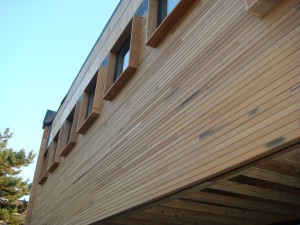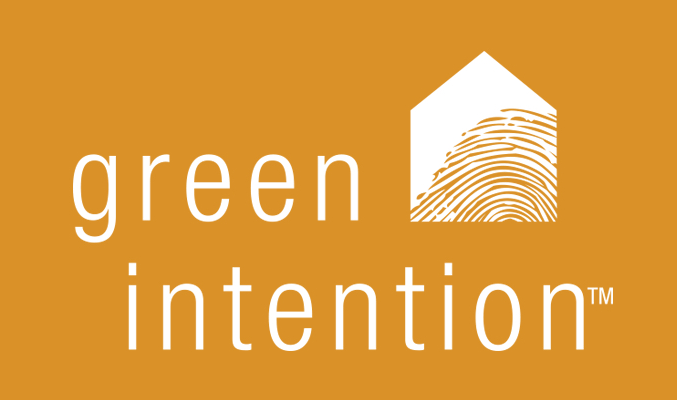 This credit by itself could put an interior designer to work for a while. It incorporates the showier, meatier essence of green homes. We spent a majority of our time on these decisions, and most questions I get from friends revolve around materials choices. (Well, I should clarify that: my female friends ask me about material choices. My male friends ask me about geothermal heat pumps, solar energy, and furnaces.) In LEED for Homes, an environmentally preferable product is a material or product that causes less environmental damage than the conventional alternative.
This credit by itself could put an interior designer to work for a while. It incorporates the showier, meatier essence of green homes. We spent a majority of our time on these decisions, and most questions I get from friends revolve around materials choices. (Well, I should clarify that: my female friends ask me about material choices. My male friends ask me about geothermal heat pumps, solar energy, and furnaces.) In LEED for Homes, an environmentally preferable product is a material or product that causes less environmental damage than the conventional alternative.
This really is the big kahuna of credits: you can get up to 8 points total. There are three components: recycled content, low emissions, and local production. Material choices here refer to those for interior and exterior walls, siding, foundation, flooring, framing, patio material, cabinets, counter tops, doors, trim, adhesives and sealants, window framing, roofing, insulation, and sheathing. I’m not sure one article will do this justice, so I’ll take them on at a time, and today focus only on the first one: recycled content–which can also mean reclaimed or FSC Certified. FSC Certified wood comes from suppliers that have been granted chain-of-custody by the Forest Stewardship Council; it is the stamp of approval that the wood has been sustainably grown and harvested.
Each component or material that meets the standard of environmentally preferable product can earn 0.5 point. Definitions are important:
- Recycled content is material that includes at least 25% post-consumer or 50% pre-consumer (postindustrial) recycled material.
- In the case of cabinets, counters, and trim, recycled-content materials must also contain no added urea formaldehyde resins to earn the 0.5 point.
- Reclaimed content is material that has been recovered from a demolition site, but only post-consumer material can be counted — not construction leftovers.
- To earn 0.5 point, at least 90% of a given component (by weight or volume) must meet the requirements.
Now, let’s look at the components LEED for Homes outlines under recycled/reclaimed/FSC certified content:
1. Exterior wall framing/wall structure: for concrete, use 30% fly ash or slag; for wood frame: FSC certified or reclaimed. Our exterior wall wood frames are all FSC Certified. 0.5 point.
2. Exterior siding or masonry: recycled content, reclaimed, or FSC-Certified. All of our exterior cypress is reclaimed from old pickle vats. It’s very pretty and durable (for wood)! However, we also have stucco and brick exterior siding. Our cypress siding does not meet the 90% requirement mentioned in the last bullet point above, so no points.
3. Flooring (0.5 point for 45% of total area; 1 point for 90% of total area): Linoleum, cork, bamboo, FSC-certified or reclaimed wood, sealed concrete, recycled-content flooring, or combination. Whew. (A LEED for Homes clarification document says that wool carpeting can be added to the list; we cannot count the garage in this equation.) We have sealed concrete in our basement, cork in my office, and reclaimed wood for our stairs. Our main level is slate tile, because that performs really well over in-floor heat. Our upstairs has wool carpet in the bedrooms and tile in the bathrooms and laundry room. So the question is, does the concrete + cork + stairs + wool carpet come to greater than 45% of the total floor area? I’ll have to get out the plans and my calculator…It turns out that if we add it all up, 52% of our flooring is either cork, reclaimed wood, sealed concrete, or wool carpet. (Would we have done anything differently to get that percentage up to 90%? We did consider putting cork everywhere, but it is such a major design decision that the LEED credits did not enter into our discussion. We are happy with our tile.) All that for another 0.5 point.
4. Floor Framing: FSC-Certified or reclaimed. The floor frames are a wood composite called timberstrand, which is very strong, straight, and resists shrinking and bowing after installation. My guess is it uses a lot less material than your typical plywood joists, but we do not get any points for it because it is not FSC-certified or reclaimed.
5. Cement Foundation: use 30% fly ash or slag. Concrete usually does have some percent recycled content. Nelson Masonry, who supplied our concrete, typically does use some percentage of fly ash, but only if the weather permits – — apparently the higher the recycled content, the longer it takes to “cure” (or dry). Since our foundation was poured in November, the weather did not permit any recycled content. No point.
6. Interior wall framing: FSC-certified or reclaimed. Our interior wall framing is all FSC-certified, so another 0.5 point.
7. Gypsum board for interior walls and framing: recycled content of 10% post-consumer OR 95% post-industrial. All of our gypsum sheet rock is made from 100% post-industrial recycled sheetrock. (We could have done otherwise, but I specifically asked about it, and it did not cost anymore to do this. We wanted to explore EcoRock, but it was not yet available when we built our house.) Here is another 0.5 point.
8. Interior walls, ceilings, and millwork paints and coatings: recycled paint that meets Green Seal standard. We did not use recycled paint, because we wanted the newer no-VOC paint. No point.
9. Landscape decking or patio material: recycled content, FSC certified, or reclaimed. Our patio is made out of concrete pavers, which probably do not have enough recycled content to warrant a half point.
10. Cabinets: recycled content, FSC certified, or reclaimed AND composite materials must contain no added urea formaldehyde resins. Our cabinetry is fir veneer over MDF core (a composite material) that specifically has no added urea formaldehyde. To get ths FSC certified, the price was significantly higher, and our cabinet maker thought the quality was less consistent. So, while the NAUF was cost about 25% more, and was a key piece to ensuring our home had healthy indoor air quality, we were not prepared to pay the additional amount for the FSC certification (most of the rest of the wood in our him is FSC-certified anyway). No point.
11. Counters (kitchens and bathrooms): recycled content, FSC-certified, reclaimed AND composite materials must contain no added urea formaldehyde resins. All of our countertops, with the exception of our butcher block kitchen counter (which would be less than 10% of all countertops) are Richlite counters. They are made from 100% post-consumer waste recycled paper and have no added urea formaldehyde, so another 0.5 point. Richlite also costs more than a comparable product like honed granite — about 10% more. We chose it not just for its superior environmental attributes, but because it is a warmer material than granite. If it is scratched, it can be buffed out easily. It is the same material as used in epicurean cutting boards, so it is very durable.
12. Doors (not including garage or insulated doors): recycled content, FSC-certified, or reclaimed. All of our doors are FSC-Certified; 0.5 point.
13. Trim: recycled content, FSC-certified, reclaimed AND composite materials must contain no added urea formaldehyde resins. All of our trim materials are FSC-Certified. 0.5 point.
14. Window framing: recycled content, FSC-certified, or reclaimed. Our windows came from H Windows and Doors, and they are made from fir. When I asked them to quote us how much more it would cost for the frames to be FSC-certified, they gave a quote that was about 50% higher than not FSC-certified. When I called them to understand how this could be, they told me that they had trouble even finding FSC-Certified fir. Apparently FSC-Certified cherry wood is easy to find and typically does not cost more, but we could not get it for the fir. (We did not change to cherry because we did not want the red color.) So, no point here.
15. Roof framing: FSC-Certified. Yes; 0.5 point.
16. Roofing: recycled content. Our roofing material is EPDM (ethylene propylene diene Monomer) membrane, a very durable, weather-resistant material often used in flat roofs. It has an added benefit of not polluting the runoff rainwater, but it is not made of recycled content. No point.
17. Roof, floor, and wall insulation: recycled content of 20% or more. For many interior walls and floors where we wanted sound insulation, we used recycled cotton denim for its superior sound absorption. For our exterior walls and roof, though, we did not use cotton denim because it can get wet and does not perform nearly as well as closed-cell spray foam (see post on insulation). Spray foam does not have 20% recycled content, so no point.
18. Roof, wall, floor (2 out of 3) sheathing: recycled content, FSC-certified, or reclaimed. Our roof and wall sheathing is all FSC-certified. 0.5 point.
Now for my commentary. For simplicity, the LEED for Homes rating system puts the non-added urea formaldehyde requirement under all environmentally preferable materials, but I believe this should go under Indoor Air Quality and be its own credit (specifically, numbers 9,10 and 12 above). Added urea formaldehyde is blamed for respiratory illnesses (see article about FEMA trailers), and is one of the number one things I tell people to specify when they are building or remodeling. Wood composites used for cabinetry like particle board and medium density fiber board commonly carry added urea formaldehyde as a binding agent. It is an unhealthy material and should not be made.
As a minor comment: there is not reward for not using certain materials. For example, the upper half of all of our walls in the basement are all exposed concrete — the foundation of our house. We therefore used less material to finish the basement, which cost less and was better for the environment, but we do not get any points. Another example is our innovative approach to cabinet drawer pulls: we cut out a hole instead. This used less material, saved money, and now nobody rams their thigh on any cabinets in our house. But LEED does not reward this either. Maybe I will submit these measures for extra points under Innovation & Design if we are close to the Platinum level. For now, I’ll leave it as just liking what we did and feeling good about it.
Adding up the points in the first part of this credit, we get a total of 4.5 points.
Materials & Resources points so far: 9
Cumulative points: 66.5
Additional points needed to get to Gold: 21.5


